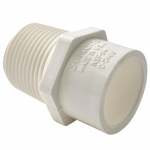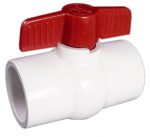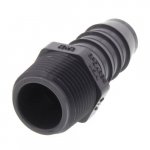Hi everyone:
Pool is 2/3 drained and I need to reroute the existing plumbing from the edge of the pool back to the pump pad. Existing plumbing is 1.5" black poly pipe going to the pool and even though the section I'm working on is higher than the main drain, water is still coming out of it. I'd like to transition from the black poly to 1.5" pvc using these adapters below installed with 2 stainless clamps. I will be gluing the pvc from this transition all the way to the pump. All of this plumbing will be buried in dirt and under concrete.
One idea is to glue a 1.5" pvc ball valve to a nipple and then glue it to this adapter below. Close the ball valve and cut the poly. Water will gush out, but I should still be able to insert this adapter's male threads into the poly pipe and tighten the clamps. The closed ball valve will then allow me to glue all of the pvc pipe up to the pad. When that's done, I'll open the ball valve and then have everything buried.
Thoughts? By the way, is there such a thing as a "temporary" plug that will dissolve after a few hours?? That way I can plug the black poly and glue all the pvc without having to use a ball valve.
Thank you!
[Black poly pipe coming out at the shallow corner of the pool]

[1-1/4" male x 1-1/2" slip pvc adapter - readily available at Home Depot]

1.5" ball valve

Pool is 2/3 drained and I need to reroute the existing plumbing from the edge of the pool back to the pump pad. Existing plumbing is 1.5" black poly pipe going to the pool and even though the section I'm working on is higher than the main drain, water is still coming out of it. I'd like to transition from the black poly to 1.5" pvc using these adapters below installed with 2 stainless clamps. I will be gluing the pvc from this transition all the way to the pump. All of this plumbing will be buried in dirt and under concrete.
One idea is to glue a 1.5" pvc ball valve to a nipple and then glue it to this adapter below. Close the ball valve and cut the poly. Water will gush out, but I should still be able to insert this adapter's male threads into the poly pipe and tighten the clamps. The closed ball valve will then allow me to glue all of the pvc pipe up to the pad. When that's done, I'll open the ball valve and then have everything buried.
Thoughts? By the way, is there such a thing as a "temporary" plug that will dissolve after a few hours?? That way I can plug the black poly and glue all the pvc without having to use a ball valve.
Thank you!
[Black poly pipe coming out at the shallow corner of the pool]

[1-1/4" male x 1-1/2" slip pvc adapter - readily available at Home Depot]

1.5" ball valve



